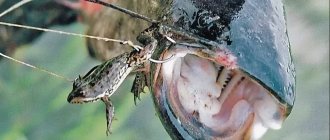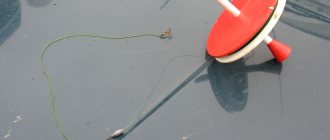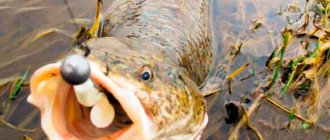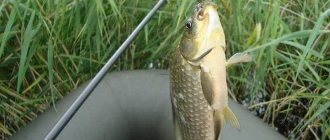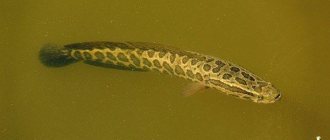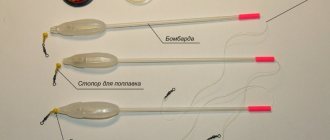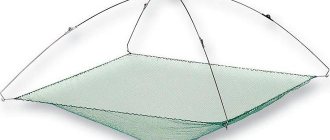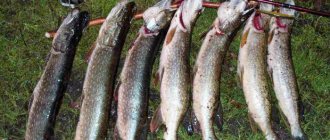general information
Frog
Frogs belong to amphibians, or amphibians. They are poikilothermic (cold-blooded) animals with an unstable internal body temperature that changes depending on the environment. The frog family is numerous. It includes more than 500 species. It is believed that the homeland of frogs is the eastern hemisphere, and more specifically, Africa. The most species of frogs are found there. Representatives of this family are found almost anywhere on the globe, excluding the Arctic snows, Australia and some areas of South America. The sizes of frogs vary greatly - from 1 to 32 cm. Their color can also be different - from brown, inconspicuous to extremely bright.
Frogs feed on small insects, but sometimes they can eat their own relatives. For hunting, they have a long sticky tongue, with which they knock down dragonflies, midges and other flying creatures in flight.
Frogs are close relatives of toads and toads. All of them form a detachment of tailless amphibians, which is opposed by a second large detachment - tailed amphibians (newts and salamanders).
Where and how long can you store a frog?
Frogs cannot be classified as bait that has a long shelf life. An amphibian, once in captivity, quickly loses its activity and attractive color. This is caused not only by the stress of being caught, but also by the fact that frogs are quite voracious in nature, constantly hunting and feeding heavily, thereby maintaining a high degree of activity.
Catfish are reluctant to bite on a passive frog, and only during periods of high feeding activity can positive results be expected. These conditions force the fisherman to constantly stock up on fresh live bait, keeping it in captivity for no more than half a day. The attractiveness of live bait, even in this short period of time, can be achieved by placing amphibians in a voluminous plastic container with a lid.
Peculiarities
These baits have the following advantages of their use:
- Live frogs live in the same environment as predatory fish, so they often become their food in the natural environment, which increases the chance of the fish biting on bait that is already familiar to it.
- Frogs have a fleshy body that holds well on the hook, unlike bloodworms or maggots.
- Frogs are an excellent bait for attracting large species of fish, in particular catfish and pike perch, which will never refuse such a delicacy.
- Bait consisting of a frog can significantly revive a weak fish bite.
The disadvantages of using live frogs as bait include the following:
- The frog must often be killed before being hooked, which is sometimes difficult for compassionate fishermen.
- Catching a frog in the natural environment can be quite difficult for anglers who have never done it before.
- Live frogs cannot be stored for long, so this bait is considered disposable.
How to catch frogs
Fishing with a non-hook silicone frog is reminiscent of fishing with poppers. But this method also has its own characteristics that must be taken into account.
Most models have natural sizes and natural colors. Manufacturers try to make the eyes large and protruding. The hook is usually pressed to the body, and the sting is directed upward. There are also products in which the hook is on the back.
Attached to the frog's mouth is a metal ring designed to engage the leash and fishing line. Particularly realistic models have paws. But the most important feature of the bait is the tufts attached at the back. They allow the non-hook to successfully overcome obstacles.
It is believed that the best time to catch pike with a rubber frog is from mid-summer to early autumn. But many fishermen successfully use this type of bait from the end of spring, when the predator hunts in sun-warmed shallow waters. It is recommended to use an artificial frog as bait in the following places:
- Duckweed. In July, the reservoirs begin to be covered with duckweed, under which life is seething. At this time, the pike bites even in hot weather and forgets about caution. A similar situation is observed in small rivers and bays of large rivers, as well as in quarries, peat bogs, ponds, and oxbow lakes.
- Driftwood and grass. In places where grass and fallen trees occupy the entire thickness of the water, a non-hooking bait is the best bait option.
- Large areas. If areas of a reservoir covered with duckweed alternate with reeds and open spaces, the search for a predator should begin with the help of a frog. This allows you to cover the largest possible area. When the fish’s habitat is discovered, it is necessary to make the spinning movements smoother or change the bait.
For pike fishing, specimens ranging in size from 6 to 8 cm are most often used. Live frogs have the same dimensions.
A non-hooking frog for pike can be made from various materials:
- rubber – suitable for fishing in reeds and on the surface;
- plastic - for reeds and open areas of the reservoir;
- foam rubber – used in clear water;
- polystyrene foam – convenient to use in shallow water;
- silicone is the most popular material, painted in natural shades.
To catch pike, you can also use homemade frogs made with your own hands.
The most commonly found frogs on sale are brown, yellow, green and black frogs.
It is important to note that the color of the frog must be natural. For example, the fish will not react to pink bait; it will seem inedible to it.
Wiring is a very important detail, without which a predator will not be interested in the bait. It is unlikely that you will be able to copy the movement of an amphibian, but you can try to make the vibrations more natural:
- After throwing the bait, you should let it sit for a few seconds. Sometimes the fish swallows its prey only when the ripples in the water disappear. After this, you can begin to carefully move the bait from the lily pad into the water and back.
- More sudden movements should be alternated with calm ones. To simulate jumping, you need to bring the spinning rod closer to the water, creating slack in the cord, and then begin to sharply move the tip of the rod. After each jerk, the spinning rod should be moved to the side so that the tension in the cord loosens.
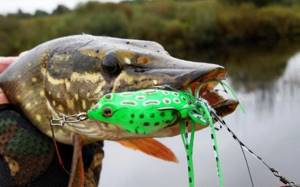
If the pike is hungry and active, it can attack prey immediately after splashing down. But sometimes you come across a cautious predator who hesitates for a long time to attack. In this case, you can tease the pike by pausing during the retrieve.
We suggest you familiarize yourself with: Fishing for crucian carp on a feeder. How to catch crucian carp on a feeder?
https://www.youtube.com/watch?v=2JzcavCG7JE
When fishing at a short distance, you can see how the pike swims towards the frog (see video below). At this moment, the line should not be tensioned. When the predator completely swallows the prey, you need to immediately hook it. It happens that the fish escapes, but still continues to hunt for the bait. In this case, you need to stop moving the spinning rod so that the frog freezes and the pike can attack it again.
It is most effective to catch catfish using bottom fishing methods, using girders or classic corded bottoms. A fish such as catfish leads a bottom-dwelling, sedentary lifestyle, practically never leaving its usual habitat throughout the entire period of its existence. Whiskered predators prefer deep holes and ditches, looking for submerged snags, tree trunks, abandoned building structures and sunken boats for shelter.
Using a frog as live bait, catfish are caught on stationary girders installed from the banks at promising fish exit points or on corded bottoms, which are mounted on flat underwater plateaus connected closely by pits located in the waters of the reservoir. These weapons are mostly used for hunting in the dark.
Fishing begins from the moment of mass release of amphibians, approximately from the second half of May until the beginning of the autumn cold, when tree frogs begin to hide and go into suspended animation. For bait, large specimens weighing from 80-100 grams with bright colors and active behavior are selected. Although among fishermen there is no consensus about the mandatory survivability of the bait, because some fishermen specifically kill the bait, leaving it in the heat until signs of spoilage appear, or even lightly frying the frogs. On most rivers, catfish are more effectively caught using live bait.
These amphibians live in any freshwater bodies of water, but their favorite habitats are coastal thickets of aquatic vegetation. In such places you can find a large number of individuals that differ in age and, accordingly, in size.
The easiest way to catch a frog is with a mesh fishing hook. The holes on it should be small so that small amphibians cannot escape from the trap. The pick-up handle should be short enough and not too heavy.
It is recommended to catch amphibians in the dark, but you will need a flashlight for this. The bright light blinds them, causing them to become motionless and obediently wait to be caught.
The easiest way to catch a frog is sitting on the ground or other flat surface. To do this, you need to carefully approach the frog at a distance equivalent to the length of the handle from the pickup, and with a quick movement cover it from above with the net. If an amphibian looks out of the water, then you need to try to catch it from below.
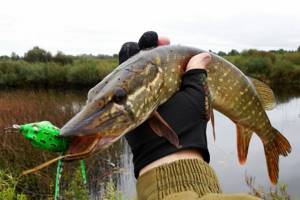
It must be borne in mind that frogs have excellent vision, but they do not see what is happening behind them. You can take advantage of this by quietly sneaking up behind the frog and covering it with a catch.
Finding frogs for fishing
Frogs are found in almost any freshwater body of water - the only difference is in the number and size of individuals. If you are not lucky enough to stock up on bait in advance, you can easily catch it on the shore. The frog prefers to be in thick grass, hide in sedge, reed thickets, thicker coastal vegetation, under stones or tree branches that have fallen into the water. Most often, you don’t really need to look for it - the baby frogs either jump out at your feet when you walk along the shore, or report their location with a loud “kwa-kwa”. You can catch frogs with a net, your hands, or any rag you can find, simply throwing it over potential bait.
Tips for catching frogs
- During the summer season, the easiest time to catch a frog is early in the morning or after sunset. During the daytime, all types of frogs usually hide in thick grass or water.
- In cold weather, frogs move to shallow water, where they lie down under stones or sheltered holes.
- To use frogs as bait, you should take small young frogs with a green color, since fish like them most.
- Frogs should be caught using a net. They should be placed in a damp cloth bag, into which the herbs must be applied in advance.
- If you can’t catch a frog with a net, you can use a regular fishing rod. To do this, attach a piece of grass or a fly to the hook. The frog will attack such bait and be caught like a fish.
- There are cases when fishermen bred frogs on their own in their own garden. To do this, you just need to collect its eggs and place them in a container of water. After two months you will be able to hatch live bait.
How to catch and where to get a frog?
To organize such fishing, you need to stock up on frogs, and they are not so easy to catch. But with certain skills and proven technique, this will not be difficult. Frogs are very curious and can be interested in literally anything. Surely many fishermen are familiar with the picture when a frog interfered with fishing by constantly jumping onto the float. This interest of the frog can be used by using a regular fishing rod with a hook. You can attach a leaf or blade of grass to the hook and manipulate it in close proximity to the frog. In about an hour you will be able to enjoy your catch, but for this you need to have patience and endurance.
You can get several frogs this way. In the immediate vicinity of the reservoir, a hole about a meter deep is dug, and the next day, looking into it, you can find several frogs. The most important thing is that they cannot get out of the hole and while fishing for several days, they can be taken as needed.
How to catch frogs
Catching a frog
There are many recommendations for preparing bait. Many fishmongers generally recommend not only killing the amphibian, but also letting it deteriorate a little or frying it over a fire - this way, supposedly, it attracts catfish more. In fact, everything is learned in practice, but two methods of catching can be considered the main ones: with a live or dead frog.
Tackle for frog fishing
Regardless of whether your bait is alive, a steel leash with a double hook (double) attached to it is used to catch it. The leash should not be very short, the optimal length is 30-40cm. It is attached to the main fishing line with a carabiner or, if you want to avoid twisting the tackle, with a swivel. Since a bite from a very large predator is possible, the main line you need to use is a fishing line with a diameter of at least 0.3 mm - this will give you peace of mind. The fishing rod, accordingly, must be strong and elastic, equipped with a high-quality inertia-free (although this is not critical) reel and capable of withstanding the resistance of a powerful opponent.
Methods for mounting a frog
Putting a frog on a hook Pond, lake, garden and swamp frogs are mainly used as bait.
Toads are not suitable for fishing. It is better to fish using a spinning rod, placing bait on a hook. When fishing for a small frog, choose hook No. 5-6, and for large frogs, accordingly, take larger hooks, up to No. 16 in size. Catfish, for example, are more likely to bite on a large frog (weighing at least 100g). There are two options for fishing with this bait: the first is with a live frog, the second is with a dead frog.
- When choosing a live frog
, you should hook it on the skin of the back or on the paw (its soft part) with the tip of the hook coming out. This method of baiting allows you to keep the frog alive. There is also a method of baiting using a double hook, when one hook is hooked onto the skin of the back, and the second hook onto the hind leg near the fin. - In the version with a dead frog,
they do it differently - they use a double hook, which is inserted through its mouth, then brought out under the front legs from the back. Next, one of the legs is thrown over the hook and the forearm of the leg is pinned onto the sting. The hook tips should come out. When retrieved, a frog mounted in this way will “play” and spin around its axis, thereby attracting the attention of the predator.
But it’s even better to put a small frog on three medium-sized hooks. The two bottom hooks are tied on short leashes under the top hook. The upper hook hooks from below to both lips or through the mouth to the lower lip of the frog, and the lower two hooks to the legs.
Features of frog fishing
With a dead frog at the end of the fishing line, do the same as with any other stationary bait: throw it in, let it lie on the bottom, and then start retrieving it. You can use the familiar step-by-step retrieve, but with the exception that the bait is moved with the tip of the rod, and not with the reel.
A live frog is also easy to use - you need to do everything as you would when fishing with live bait. We chose a place, cast it, and made sure that the bait did not crawl under a snag, hide in the grass, or settle under a stone. Since the frog will tug on the tackle much more actively than live bait, the load must be taken heavier than when fishing with live bait so that it does not move it from its place.
A bite is usually accompanied by a strong blow, but you should not immediately grab the rod and start reeling out the line. Wait a few seconds for the predator to better swallow the bait, and only then hook it. How to fish, you need to look at the place. If everything is clear and level on the bottom and in the surrounding area, you can give the fish a little slack, thereby tiring it and increasing your chances of success. If you know that there are a lot of snags, there are dense thickets and other shelters nearby, you can force the reeling so that the trophy does not have time to hide in such a shelter, from where you will never get it, but will simply break off the tackle.
Methods of catching a frog
There are several ways to catch catfish with a frog. In spring, summer and autumn, in the dark, when catfish come out to the shoreline to feed, they are caught with baits and hooks. They are attached to poles stuck into the bottom or tree branches hanging over the water. In this case, part of the nozzle is lowered to the bottom, and the other part is left in the water column, thereby determining the most promising horizons.
In the daytime, at depth, far from the shore, it is more effective to fish with quok. The fisherman, having lowered the tackle into the water, slowly floats downstream over pre-explored holes, guiding the frog attached to the hook at medium depth and near the bottom.

When choosing one or another method of catching catfish with a frog, you should remember that due to its physiological state, an amphibian hooked on a hook cannot remain under water for more than 30 minutes. After this time, and sometimes even earlier, the frog suffocates and becomes less attractive to the catfish.
This type of fishing is an active fishing method and involves periodically pulling the bait out of the water. Having taken out the frog, you need to let it catch its breath for at least 10-15 minutes, after which it can be returned to the water again.
Artificial frogs
Today there are a wide variety of silicone frogs classified as artificial baits. Their range and supplies are quite large. So-called frog fishing rods are also produced, which, unlike others, have greater power.
The main purpose of frogs extends to three types of predators: snakehead, bass and pike. Moreover, catching pike with a frog will be less successful in relation to the other two species.
As a rule, the plastic itself for this class of baits is chosen to be more durable than for worms or twisters. Here we are talking about frogs, most of which are supplied already equipped with hooks and each bait is in a separate blister.
The cost of such a frog exceeds the cost of simple rubber ones. Do not forget that frogs should not be stored together with other baits. Otherwise, the possibility of a chemical reaction between them is very high, which will negatively affect the frog.
Frog as bait: advantages and disadvantages
If the surface of the reservoir is covered with duckweed or other algae, then an artificial frog is the only bait that is suitable for such conditions. Rubber frogs pierce the green cover of a pond or lake well and do not catch the grass during the wiring process. But this attachment also has its weaknesses that need to be taken into account.
The list of advantages of fishing with artificial amphibians is as follows:
- this attachment is durable and equipped with a double hook;
- fishing stores offer a wide range of artificial baits, so the angler has the opportunity to choose bait for any conditions;
- such a bait looks believable due to realistic movements in the water;
- sharp Japanese hooks, which are installed on silicone frogs, reliably detect fish.
The list of disadvantages of an artificial substitute looks like this:
- not all models are catchy (you can only select a working bait using an experimental method);
- Such baits cannot be called budgetary, since they are more expensive than spinners and jig heads.
Live frog
These animals belong to the class of amphibians, the order of tailless animals and the family of true frogs. They do not have a neck, since the head immediately passes into the body. Convex eyes on a flat head are located on the sides. They can see everything happening in front, above, left and right at the same time. During sleep, the eyes do not close.
The nostrils are equipped with special valves that prevent water from entering the respiratory system. The front paws have 4 toes. The hind legs of the amphibian have 5 toes, connected by membranes. The skin is covered with mucus, which is secreted by special glands. Color can vary from green to dark brown (this depends on the habitat).
Amphibians reproduce by laying and fertilizing eggs. The larvae, called tadpoles, hatch after about 10 days. They breathe through gills, absorbing oxygen dissolved in the water, and live for about 4 months. In a young amphibian that has passed the tadpole stage, the tail atrophies and paws grow. After 3 years she reaches sexual maturity.
Getting rid of frogs
Before you start fighting amphibians, you need to understand whether they cause harm. Often, an invasion of frogs provokes the appearance of insects and slugs in basements. From frogs you will receive the help of natural enemies in destroying these pests. It is worth considering various methods for breeding frogs if there are no such pests or the spread of amphibians is widespread.
Before choosing ways to get rid of toads or frogs, you need to eliminate the root cause of their appearance. Often after this they leave the cellar themselves. It is better to take these measures in the spring: then you will not need to make additional efforts. There is a high probability that the frogs will disappear over the summer. It is important to assess the number of amphibians and the potential damage they can cause, and choose: get rid of the toads or leave everything until the fall.
When considering means of control, you need to find a middle ground between their effectiveness and safety. This applies to both chemicals and mechanical devices. Pets and children may be poisoned or injured.
Nets and traps for frogs
This method does not require killing amphibians, but allows you to significantly reduce their number or get rid of them completely.
The nets have proven themselves well in open space conditions. Traps are useful in cases where it is impossible to remove the contents of the basement. They are installed in open space. A prerequisite is the presence of bait.
You can make nets and traps with your own hands from available materials or use a regular net. A fishing or children's one for butterflies is perfect. To collect caught frogs, you will need a tall container with a narrow neck or a closing lid. This way the pests will not jump back out.
Mousetraps are suitable as traps. An excellent bait would be food waste or special granules that are used for mice and rats.
Good homemade traps for fighting frogs in the basement can be made from a fishing net. It is enough to pull it diagonally from the floor to the ceiling. Attach a light bulb on the side opposite to the cluster of toads. It will attract insects, which will become a natural bait for amphibians. Instead of a grid, a tall barrel with a light source located above it is suitable. The frogs will jump after the mosquitoes and end up in a container from which they will not be able to escape.
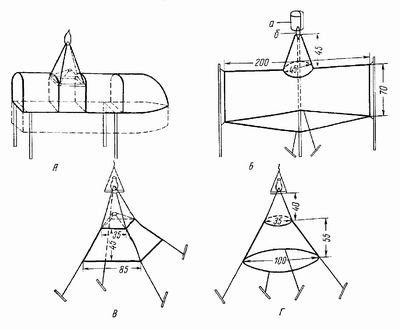
Chemicals
The method involves the use of potent poisons. Such drastic measures to remove amphibians from the cellar are best left for last. If there are animals or children, you will have to additionally fence the cellar, since chemicals getting on the skin or in the digestive system can lead to burns or poisoning.
Before purchasing, you need to carefully read the instructions for the anti-frog product and pay attention to the following nuances:
- degree of danger to others;
- the need to remove the contents of the cellar;
- time of action;
- mode of application;
- residual effect.
Chemicals are more often used if other measures do not help get rid of frogs. In this case, you need to give preference to powerful drugs. They will require the removal of all contents from the cellar. Be sure to check the expiration date of the composition and after it has expired, ventilate the room well. The poison should be spread in areas where amphibians are most likely to move: at the entrances to the basement, near burrows, cracks in walls and floors.
If there are no special means to combat frogs, the use of universal insecticides and compounds against snakes is allowed.
Folk methods of struggle
Before starting to use poisons, many people think about how to remove frogs using safe means. Often the effect is no worse. Thanks to this, the toad will not die, but will simply get scared and run away. Well proven in practice:
- Lemon acid. You need to prepare a strong solution: 400 g of powder per 4 liters of water. All horizontal surfaces are sprayed with it. It irritates the skin, causes burns, and in high concentrations kills frogs.
- Salt. It is enough to scatter it on the floor. Frogs will get burned if they come into contact with the crystals. The remedy is rarely fatal, but it forces frogs to change their habitat. In addition, salt absorbs moisture well. This will help dry the room further.
- Very strong coffee. It works in a similar way. The surfaces are sprayed with the decoction. The use of coffee grounds is allowed; they are laid out at entrances and cracks.
Are frogs dangerous?
Of course, the appearance of amphibians, their slippery pimply skin, evokes tenderness in few people. Meeting such a neighbor on your property, or even more so in your house, is not very pleasant for most summer residents. In addition, there are many negative signs associated with toads. But do they cause tangible harm?
Some gardeners attribute spoilage of strawberries, wild strawberries, and cellar supplies to frogs. It should be noted that this is a common misconception: toads feed only on living food and only moving food. This is how their digestive system works. Therefore, they are not only unable to damage plants growing in the garden or supplies stored in the cellar, but, on the contrary, they destroy real pests - the Colorado potato beetle, slugs and others. However, many of the insects that amphibians feast on are unattractive to birds.
There is also a misconception that touching a toad can cause an allergic reaction or the appearance of warts. It has long been proven that substances found in the wart growths of toads living in Russia are used by amphibians for protection from predators and are mostly safe for humans. Blaming frogs for the appearance of warts is a prejudice, and nothing more.
Uninvited guests usually try to sneak into houses and basements in the fall in order to wait out the winter frosts in secluded corners, entering suspended animation. In the spring, temporary cohabitants will leave the shelter and again settle in the surrounding area.
Thus, there is no real need to fight amphibians that have settled in domestic buildings. In addition, by driving frogs out of your territory, you can disrupt the ecosystem and contribute to the proliferation of harmful insects with your own hands. If you nevertheless decide to remove frogs from the yard, we offer you ways to combat them.
